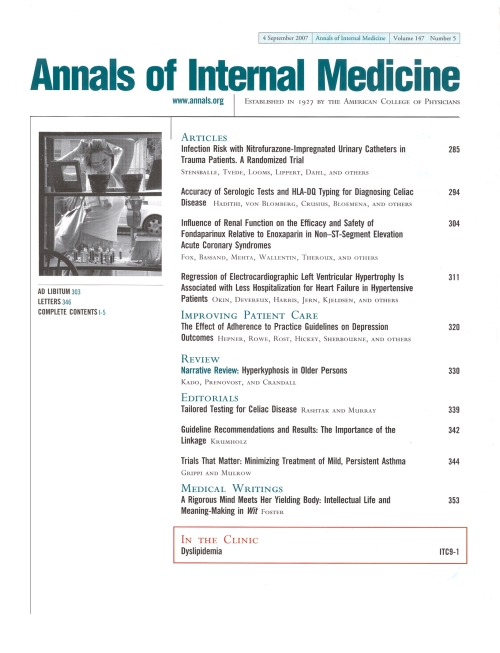
Exercise and ultrasonography are effective in treating adults with knee osteoarthritis

Exercise and ultrasonography are effective in treating adults with knee osteoarthritis
Physical therapy interventions for knee pain secondary to osteoarthritis: A systematic review
Ann Intern Med. 2012 Nov 6;157(9):632-44. doi: 10.7326/0003-4819-157-9-201211060-00007Did you know you're eligible to earn 0.5 CME credits for reading this report? Click Here
Synopsis
This meta-analysis and systematic review included 193 studies (84 randomized controlled trials were assessed in the meta-analysis) comparing physical therapy to a control group in patients with knee osteoarthritis (OA). The most effective interventions were ultrasonography, and aerobic, aquatic, strengthening, and proprioception exercise. Education, orthotics, taping, tai chi, and pulsed electromagnetic fields had no clinically significant effect on any of the patient-centered or functional outcomes of interest. Few adverse events occurred in the studies.
Were the search methods used to find evidence (original research) on the primary question or questions stated?
Was the search for evidence reasonably comprehensive?
Were the criteria used for deciding which studies to include in the overview reported?
Was the bias in the selection of studies avoided?
Were the criteria used for assessing the validity of the included studies reported?
Was the validity of all of the studies referred to in the text assessed with use of appropriate criteria (either in selecting the studies for inclusion or in analyzing the studies that were cited)?
Were the methods used to combine the findings of the relevant studies (to reach a conclusion) reported?
Were the findings of the relevant studies combined appropriately relative to the primary question that the overview addresses?
Were the conclusions made by the author or authors supported by the data and or analysis reported in the overview?
How would you rate the scientific quality of this evidence?
Yes = 1
Uncertain = 0.5
Not Relevant = 0
No = 0
The Reporting Criteria Assessment evaluates the transparency with which authors report the methodological and trial characteristics of the trial within the publication. The assessment is divided into five categories which are presented below.
4/4
Introduction
4/4
Accessing Data
4/4
Analysing Data
4/4
Results
3/4
Discussion
Detsky AS, Naylor CD, O'Rourke K, McGeer AJ, L'Abbé KA. J Clin Epidemiol. 1992;45:255-65
The Fragility Index is a tool that aids in the interpretation of significant findings, providing a measure of strength for a result. The Fragility Index represents the number of consecutive events that need to be added to a dichotomous outcome to make the finding no longer significant. A small number represents a weaker finding and a large number represents a stronger finding.
Why was this study needed now?
Although osteoarthritis (OA) is already one of the foremost causes of disability among noninstitutionalized adults today, its prevalence continues to increase as the population ages. Nonsurgical treatments for OA such as physical therapy are prescribed in the hopes of reducing pain and disability, and improving function and quality of life. This meta-analysis and systematic review aimed to be the first to evaluate the effectiveness of different exercise types and nonsurgical interventions in order to determine which physical therapy treatments are best for patients with osteoarthritis of the knee.
What was the principal research question?
Is physical therapy more effective than a control treatment with respect to patient-centered outcomes, function, and complications in patients with osteoarthritis of the knee?
What were the important findings?
- Education, orthotics, taping, tai chi, and pulsed electromagnetic fields had no clinically significant effect on any of the outcomes of interest
- There was a significant reduction in pain when patients received proprioception exercise (4 studies; SMD, -0.71 [95% CI, -1.31 to 0.11]) or diathermy (5 studies; significant at 1 month only; SMD, -0.53 [CI, -0.96 to -0.10]); the two interventions did not demonstrate significant effects for any other outcomes
- Massage led to a significant improvement in composite function (3 studies; SMD, -0.55 [CI, -0.93 to -0.18])
- Aquatic exercise resulted in significantly reduced disability (3 studies; SMD, -0.28 [CI, -0.51 to -0.05])
- According to 11 studies, aerobic exercise significantly reduced long term pain (SMD, -0.21 [CI, -0.35 to -0.08]; this was not clinically significant), disability (SMD, -0.21 [CI, -0.37 to -0.04]), composite function within 3 months (WOMAC function score -15.4 [CI -24.8 to -5.92]), and gait function over 12 months (walking speed difference -0.11 m/s [CI, -0.17 to -0.05])
- Results from 9 studies demonstrated that strengthening exercise resulted in clinically significant reduction in pain (SMD, 0.68 [CI, -1.23 to -0.14]) and improvement in composite function (SMD, -1.00 [CI, -1.95 to 0.05])
- electrical stimulation significantly improved global assessment scores in two studies and muscle strength at 3 months in two studies (values not provided)
- According to 6 studies, ultrasonography led to clinically significant improvement in pain (SMD, -0.74 [CI, 0.95 to -0.53]), composite function (SMD, -1.14 [CI, 1.85 to -0.42]), and gait function (SMD, -1.48 [CI, 2.08 to -0.89])
What should I remember most?
Aerobic, aquatic, strengthening, and proprioception exercise, as well as ultrasonography were shown to be effective in improving patient-centered outcomes and/or function.
How will this affect the care of my patients?
This study demonstrated with low-strength evidence that aerobic and aquatic exercise improved disability and that aerobic exercise, strengthening exercise, and ultrasonography reduced pain and improved function. However, further investigation is required based on the limited evidence for individualized treatment decisions.
Learn about our AI Driven
High Impact Search Feature
Our AI driven High Impact metric calculates the impact an article will have by considering both the publishing journal and the content of the article itself. Built using the latest advances in natural language processing, OE High Impact predicts an article’s future number of citations better than impact factor alone.
Continue



 LOGIN
LOGIN

Join the Conversation
Please Login or Join to leave comments.